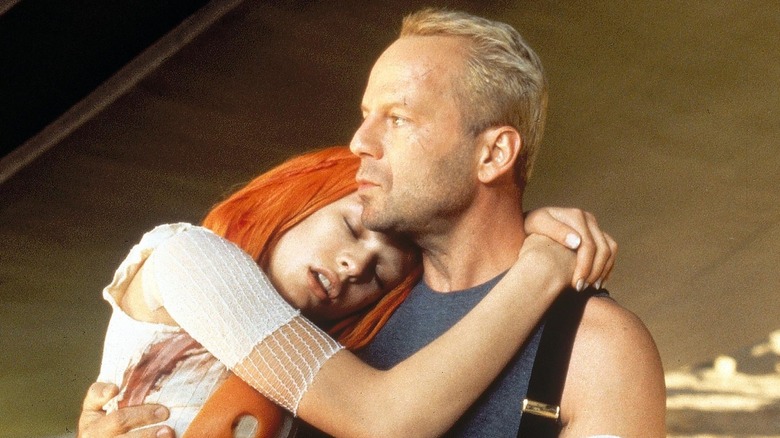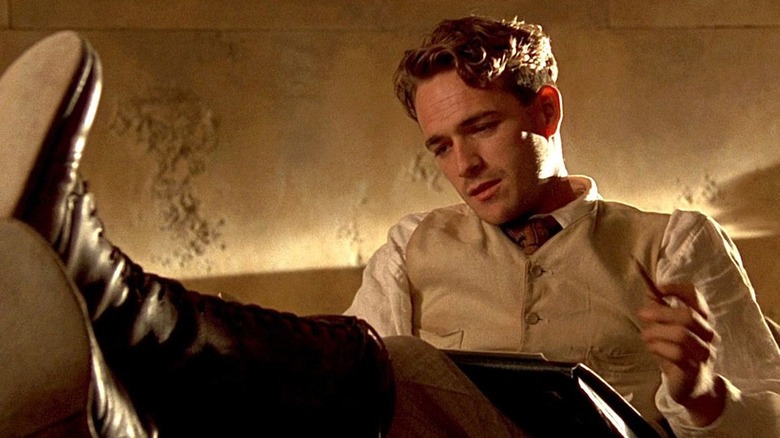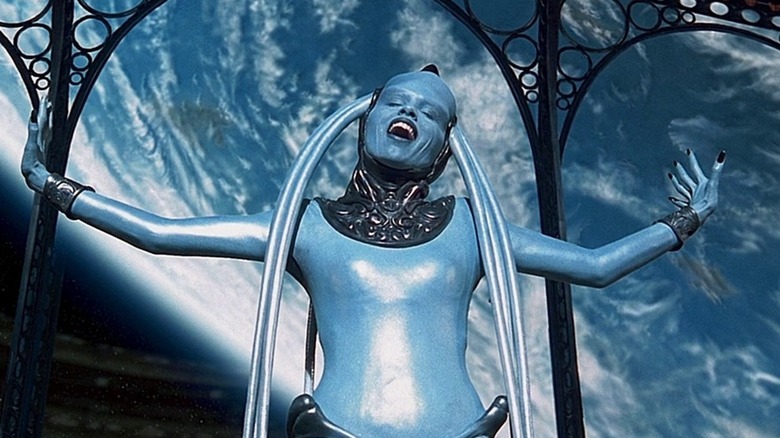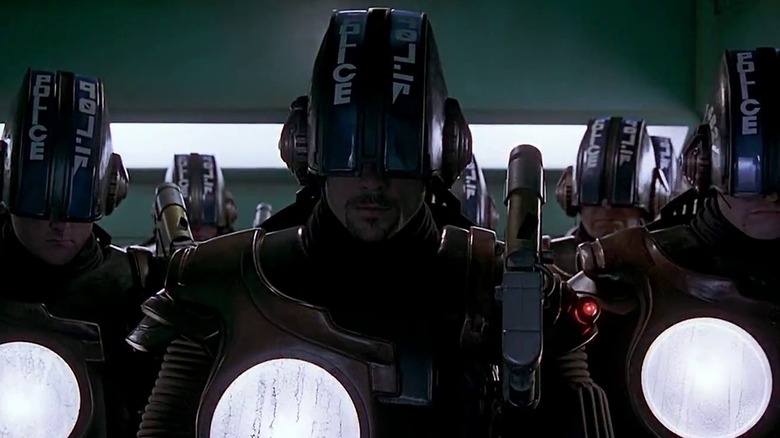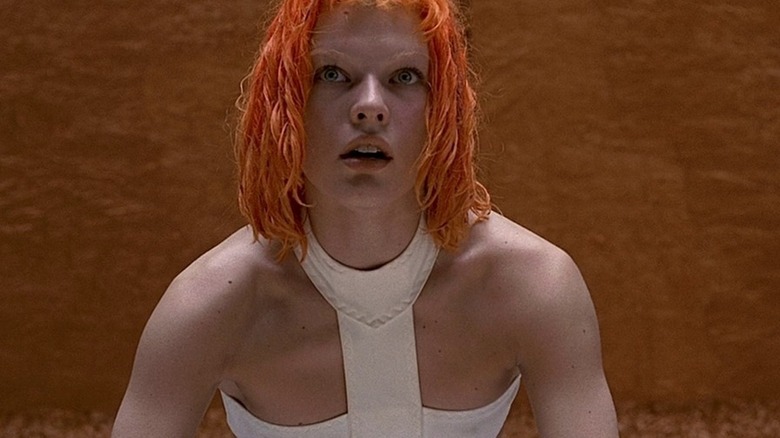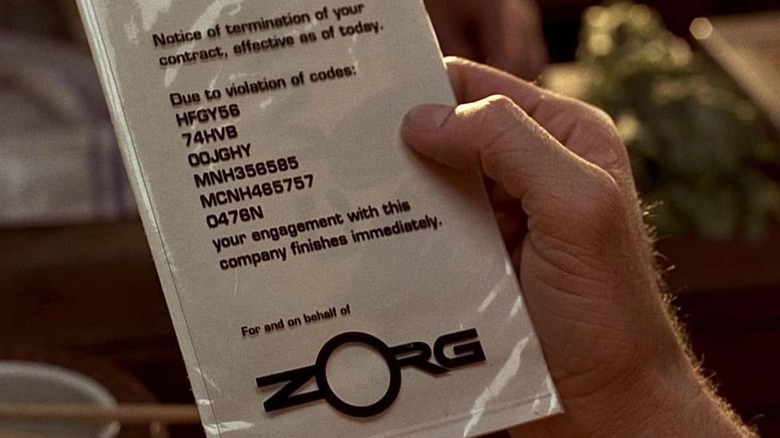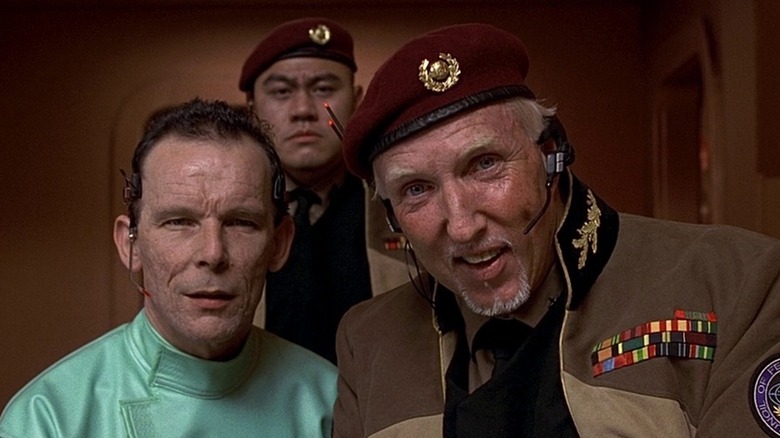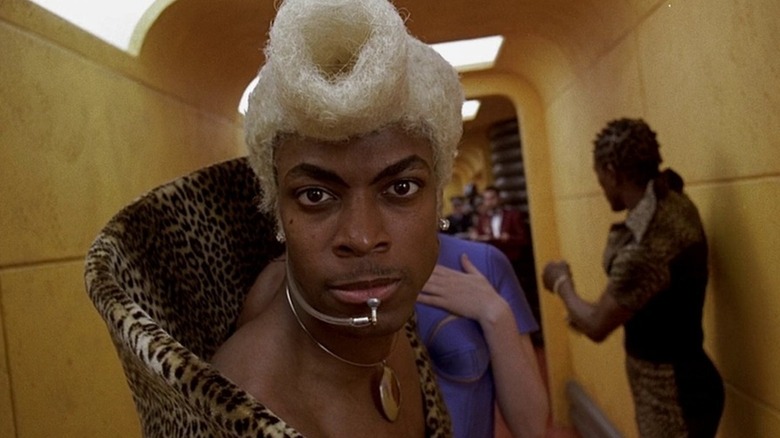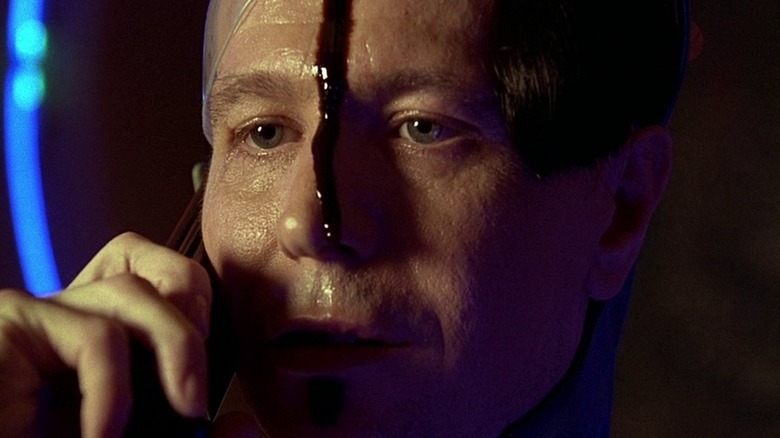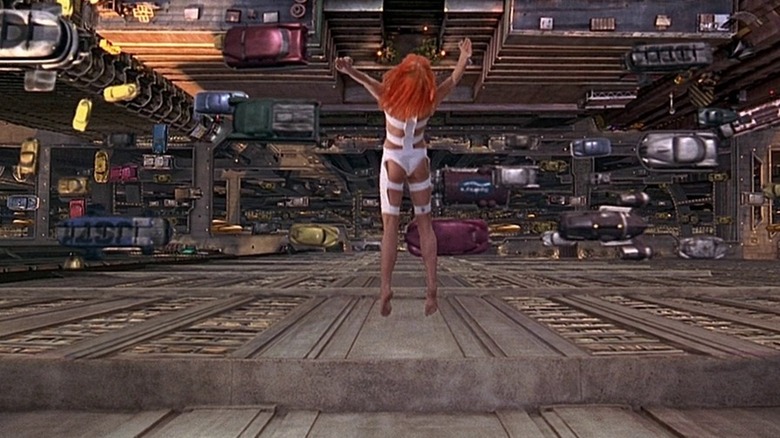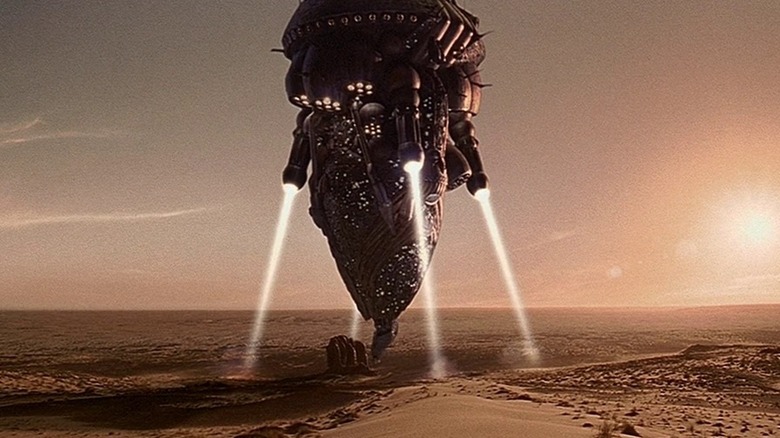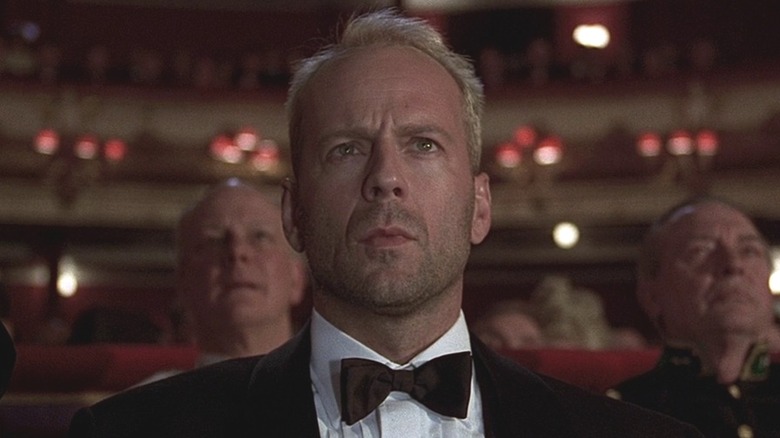Things You Only Notice In The Fifth Element The Second Time Around
Though it bombed at the box office back in 1997, "The Fifth Element" has become the ultimate sci-fi cult classic. There's a story behind that transformation, but it really comes down to the incredible amount of work that dozens of people put into making the movie a reality. Director Luc Besson set out to create one of the most imaginative and funny sci-fi films to date, and without a doubt, he succeeded.
"The Fifth Element" centers on taxi driver Korben Dallas (Bruce Willis) and resurrected perfect being Leeloo (Milla Jovovich). The unlikely couple have a chance meeting that leads them out into deep space and on a quest to save the world from a galactic-scale evil threat. In the background of their grand adventure is a deeply intriguing world filled with alien opera singers, incompetent government officials, and capitalist villains willing to sacrifice Earth for power.
Besson's film is the kind of movie that warrants multiple viewings. Plenty of its fans were kids in 1997 and are just now realizing how many details in "The Fifth Element" were just for adults. It's not all raunchy humor and political satire, though. If you haven't seen "The Fifth Element" in a while, there's plenty of good and bad to be discovered on a second viewing.
Was that Luke Perry?
"The Fifth Element" has a truly star-studded cast. It's not every day you see people like Bruce Willis, Milla Jovovich, Ian Holm, and Gary Oldman all sharing the screen. Even the movie's smaller characters are played by excellent actors like Brion James and Tom Lister Jr. — and then of course there's Chris Tucker's character, Ruby Rhod.
The first time you watch the movie, it's easy to be so starstruck that you actually miss one or two big stars who get featured in the movie. On a second pass, though, you'll notice that even extremely minor characters are played by recognizable actors.
There's a reason, for instance, why Billy looks so familiar in the beginning of the movie. Billy is a research assistant who witnesses aliens landing on Earth in 1914. He's got a very small part to play in the movie, which is a little strange considering he's played by Luke Perry. By 1997 Perry was an established star, with seven years of "Beverly Hills 90210" and plenty of other roles under his belt. Perry is the kind of actor who regularly showed up in unexpected places, but even when he doesn't have that much to do in a movie, he brings a certain level of charm to a character.
The score is even better than you remember
People pay plenty of attention to the visual effects in "The Fifth Element," and they should: Everything from model work to murals to prosthetics got used to make the sci-fi world of Luc Besson's imagination come to life. The visual style of "The Fifth Element" sticks with you long after you watch the film, and revisiting it down the road, you'll realize that the movie looks just as good today as it did in 1997. The visuals are so good, in fact, that they just might distract you from how incredible the movie's score really is.
The first time, it's easy to lose track of the music and get lost in the action, but watching the movie a second time makes the score really stand out. At every step of the way the music supports what's happening on screen, but there are some moments that are even more striking than the visual effects. The passage playing during Leeloo's initial escape into Korben's taxi is a particular highlight.
Of course, the biggest musical moment comes during Diva Plavalaguna's performance. Composer Eric Serra knew that creating an alien opera was a tall order, and he wrote the piece to purposely include notes beyond the reach of the human voice. Opera singer Inva Mula recorded the vocal performance, and she was actually able to sing a majority of what Serra had written. Some careful digital editing took care of the rest and perfected Plavalaguna's otherworldly song.
2263 desperately needs police reform
At its heart, "The Fifth Element" is an adventure story. Korben's chance encounter with Leeloo sends his life spiraling in a new direction, and the two of them end up racing across deep space to save the universe from evil. The movie introduces some dazzling locations and sci-fi concepts, but it doesn't spend nearly as much time developing them as it does rushing through the plot. That's why every time you rewatch the movie, you'll notice new small details about the world — and sometimes they're a little concerning.
By the end of the movie, we don't know all that much about New York City circa 2263, but we've gotten enough details to learn that the city is a borderline dystopia. Korben's life as a taxi driver gives us a glimpse into the capitalist nightmare that seems to have taken over this version of the future, and his chase with the police lets us know that New York really needs to consider some drastic reform measures.
As Korben's taxi races past a police hover car early in the movie, we see that the NYPD of 2263 wears full metal body armor at all times, even if they're at a fast food drive-thru. When the police start to pursue Korben, it quickly becomes clear that collateral damage isn't a concern for them. They all but tear apart the city trying to get Korben, and they don't even succeed. Life as a pedestrian in this future NYC has to be a bit scary.
Leeloo speaks a real language
When Leeloo lands in the back of Korben's taxi, she doesn't know where she is, and she definitely doesn't know how to speak English. Considering that she's just been essentially resurrected and brought into the future from thousands of years in the past, she learns how to communicate remarkably quickly. Though she picks up more and more English as the movie progresses, most of the time Leeloo speaks a language beyond anyone's comprehension.
At least, most of the people in the movie have a hard time understanding her. In reality, the language that Leeloo speaks is entirely real, and it was created by director Luc Besson just for this movie. Besson spent 15 years developing the world of "The Fifth Element," and in all that time he also spent some effort creating a dictionary for the Divine Language. Besson invented around 400 words so that Leeloo could, in theory, say everything she needs to say through the entire movie in a real language. Besson and Milla Jovovich both became so fluent in the Divine Language that they even used it to communicate with each other while filming.
Did Korben work for Zorg?
"The Fifth Element" gets more mileage than most movies out of playing with tropes and character archetypes. The story has a traditional big evil and a chosen one destined to defeat it. Leeloo and Korben both get to play out different takes on the hero archetype, while Zorg (Gary Oldman) stands in for the movie's real villain. The movie sets up a story that's initially familiar, but it subverts the usual formula whenever it can.
One of the oddest parts about "The Fifth Element" is that the heroes and the villains never actually see each other face to face. Obviously the big space evil is a kind of amorphous entity that would probably have trouble standing on the surface of Earth, but Leeloo and Korben never even meet Zorg, the evil's human representative. They save the day without ever properly squaring off against Zorg, but that doesn't mean they have no connection to Zorg whatsoever.
After using his taxi to escape from the police, Korben loses his job, and that's actually Zorg's first strike against our heroes. The first time they watch the movie, most people probably miss a small detail on Korben's termination notice. Zorg owns the company that fires Korben, so even though the two never directly meet, their conflict is still personal.
The future's military needs better leadership
According to "The Fifth Element," by 2263 humanity will have spread out to the stars and made contact with alien civilizations. Earth will be filled with sprawling cities, hover cars, and the kind of technology that lets you regrow life from tissue samples. The future sounds amazing, but when you really think about the people who are in charge of the planet, you might have second thoughts about that.
Earth's military has a big role to play in "The Fifth Element." They're the ones who make first contact with the great evil that employs Zorg, and they eventually help send Korben and Leeloo on their journey to save the world. It might be fair to say all's well that ends well, but the movie shows us over and over again how incompetent the future leadership of Earth really is.
The President, played by Tom "Tiny" Lister Jr., never seems to have any idea what's really going on. He's willing to take advice from Ian Holm's Cornelius, despite having very little evidence that the priest knows what he's talking about when it comes to epic space evils. The military, on the other hand, is represented by Brion James's character General Munro. You'd want a general to have a sound tactical mind, but Korben manages to outsmart Munro, leaving him trapped in a freezer in his apartment while he escapes with Leeloo. The movie is definitely saying something about people in power, but it's also depicting a future we'd all be better off avoiding.
Even the characters are surprised by Chris Tucker
"The Fifth Element" is filled with great performances, but Chris Tucker's appearance as Ruby Rhod is one of the most memorable parts of the entire movie. From clothing to hair, Ruby's sense of style is something that you won't forget after seeing it. Tucker brings a tremendous amount of energy to the role, transforming Ruby into an unbelievably entertaining powerhouse entertainer. Ruby immediately steals the scene, and even the characters in the movie seem to be a bit stunned by Tucker's performance.
It turns out that everyone on set probably was just as surprised by Tucker as anyone who's ever watched "The Fifth Element." Tucker told EW that when he took the part, hardly anyone knew what the role was supposed to be. "They were really protective of the script," he recalled. "They didn't let anyone know what the part was." Even Tucker himself was kept mostly in the dark. All he knew was that Prince was supposed to play the role, but he passed it up because the costumes were too outlandish. Tucker didn't know what to think, until he saw the costume for himself.
"I was kind of like 'Whoof, this is a deep, deep character,'" Tucker said, adding, "But all that stuff really helped me get into character." Get into character Tucker did, and the movie's other actors couldn't help but let their genuine reactions to Tucker's performance bleed into their own work.
Zorg might be Gary Oldman's scariest villain
Gary Oldman is one of the greatest character actors of his generation. He's played some heroic characters, like Detective Jim Gordon in the "Dark Knight" trilogy and Sirius Black in the "Harry Potter" films, but Oldman really shines as a villain. Whether he's playing a shapeshifting vampire in "Bram Stoker's Dracula" or the crazed mayor of a post-apocalyptic town in "The Book of Eli," Oldman brings a chilling energy to all his baddies.
Amidst all the aliens and shiny scenery, it can be easy to lose track of Oldman's character Zorg in "The Fifth Element," but the second time through you'll realize how terrifying he really is. What makes Zorg so scary isn't that he's working for a terrible evil, but that communicating with his evil boss seems to shake Zorg to his very core. On the phone with the evil entity, Zorg's head spontaneously starts bleeding, and his own terror is very apparent. Despite his fear, he keeps trying to help the evil grow in power.
Oldman's performance in the movie is even more impressive if you know the context surrounding it. In an interview with Role Recall, Oldman admitted that he only took the role as a favor to Luc Besson. He didn't even read the script before agreeing to be in the movie, and it doesn't sound like he's a huge fan of the finished product. When told that "The Fifth Element" has become a cult classic, Oldman just laughed and said, "That's the wacky world we live in."
Leeloo may have inspired another sci-fi hero
As a character, Leeloo is obviously based on "chosen one" tropes that are as old as time itself. The movie repeatedly says that she's supposed to be a perfect being. It's not just that Leeloo is destined to save the world, but also that she has some borderline magical abilities. She's an incredibly fast learner, and all but a champion fighter with little to no training whatsoever. Korben plays a central role in the story, but it's really Leeloo who's the hero of "The Fifth Element."
As much as she's based on mythological heroes from stories that came before her, Leeloo has also gone on to inspire other sci-fi heroes. Her influence can easily be seen in characters like River from "Firefly" and "Serenity," but she has a very particular similarity with another major '90s sci-fi "chosen one." In the movie Leeloo learns how to fight — and a majority of human history — by watching video feeds on a small screen. She basically downloads the knowledge into her head. Two years after the debut of "The Fifth Element," Neo learns his own fighting techniques using a very similar method in "The Matrix."
There's no replacement for practical effects
There are plenty of '90s sci-fi movies that don't hold up visually today. CGI has come a long way in the past three decades, and movies that went all in on the technology back then are really starting to show their age. "The Fifth Element" has no shortage of special effects, but the movie still looks fantastic today because so much of what happens on screen was created practically.
Luc Besson knew that his movie was going to demand an excessive amount of visual effects. It took more than 160 people to create the 220 visual effects shots that made it into the movie, and the team filmed plenty more that didn't survive the editing room. Besson employed model makers and artists to make his world as realistic as possible. The spaceships shown in the movie are real models. So is Korben's taxi, and even some of the New York City streets that he flies it down. A second viewing gives one plenty of time to really appreciate the level of effort that went into making "The Fifth Element" as visually engaging as it is.
The movie is plagued by stereotypes
Unfortunately, not everything that you notice about "The Fifth Element" when watching it again is good. There are plenty of things to praise about the movie, from the performances to the music to the visual effects, but decades later it also stands out for being filled to the brim with misogynist stereotypes.
There's no way around it: "The Fifth Element" does a terrible job depicting women. Leeloo is basically the only human woman on screen the entire movie, and even though she's a hardcore action hero, she still ends up falling into the damsel in distress role more than once. As badass as Leeloo may be on her own, the movie doesn't let her be a hero without the help of Korben. She's also wearing little more than some strategically placed bandages for the first third of the film.
It's the other women in the movie that get a really problematic portrayal. Korben's mother and ex-wife — heard only as voices talking to Korben over the phone — are depicted as greedy nags who won't let Korben live his life in peace. They call Korben to ask him for money or berate him for supposedly going on vacation, and the movie plays these moments for laughs as Korben rolls his eyes and desperately tries to avoid interacting with them as much as possible. Those cringe-worthy moments don't ruin the film by any means, but they may tarnish your memories of it on that second viewing.
